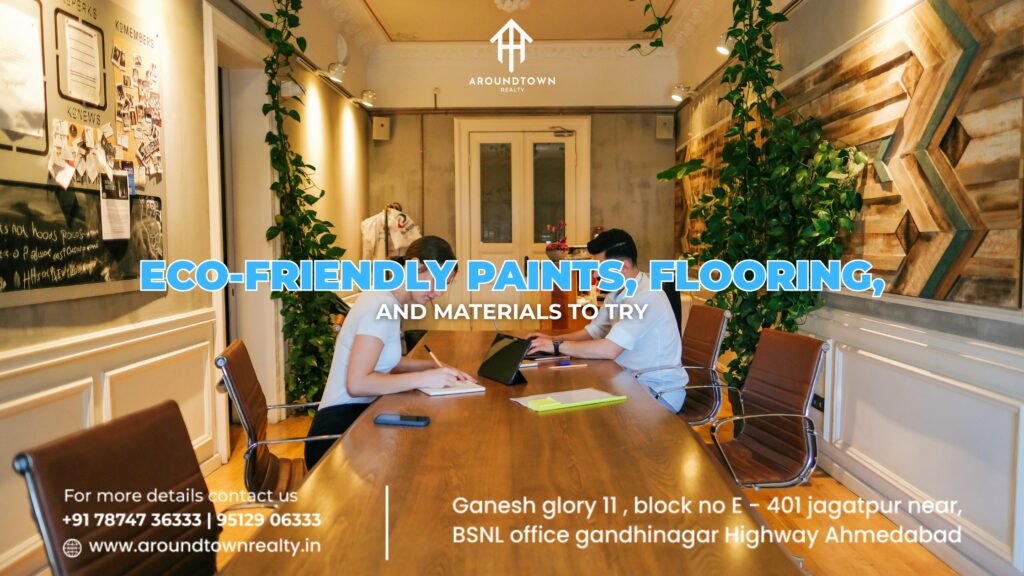Introduction: Eco-Friendly Paints, Flooring, and Materials to Try in 2025
As sustainability becomes a non-negotiable in how we live and build, choosing the right finishes for your home is more than just a design decision—it’s a conscious commitment to health and the environment. In 2025, homeowners and builders alike are increasingly opting for eco-friendly paints, flooring, and materials that not only reduce environmental impact but also enhance indoor air quality, energy efficiency, and long-term durability.
Whether you’re building a new house, renovating a flat, or simply refreshing your space, exploring eco-friendly paints, flooring, and materials to try can make your home healthier, more sustainable, and future-ready. This guide will walk you through the best options available in India, their benefits, and how to source them smartly
1. Eco-Friendly Paints: Breathe Easy, Live Better
a. Low-VOC and Zero-VOC Paints
Traditional paints release volatile organic compounds (VOCs) into the air, which can cause headaches, allergies, and long-term health issues. Eco-conscious alternatives are now readily available.
Top Choices in India:
- Asian Paints Royale Atmos – Absorbs pollutants and neutralizes odors
- Nerolac Impressions Eco Clean – Low VOC and eco-certification compliant
- Berger Breathe Easy – Formaldehyde-free, anti-bacterial formula
b. Natural and Mineral-Based Paints
Made from ingredients like lime, clay, chalk, or plant dyes, these paints are biodegradable, safe for pets and children, and have a soft, matte finish.
Where to Try:
- Local artisans offering lime-based wall finishes
- Import options like ECOS Paints or BioShield, if you want ultra-natural paints
Benefits of Eco-Paints:
- Better indoor air quality
- Reduced carbon footprint
- No lingering chemical odors
- Kinder to children, pets, and allergy-prone individuals
2. Sustainable Flooring: Earth-Friendly Underfoot
a. Bamboo Flooring
Stronger than most hardwoods and regrows in just 3–5 years. Bamboo is a renewable, stylish, and durable option for Indian homes.
Pros:
- High durability and tensile strength
- Natural finish with modern appeal
- Suitable for humid Indian climates
Brands to Explore:
- Span Floors
- Greenlam
- Notion
b. Cork Flooring
Harvested without cutting down trees, cork flooring is made from the bark of cork oak trees and is naturally hypoallergenic, antimicrobial, and soft underfoot.
Ideal For:
- Bedrooms
- Home offices
- Kid-friendly zones
c. Reclaimed Wood Flooring
Reusing old timber from warehouses or old homes, this option offers distinctive character with zero new-tree impact.
Bonus: Every plank tells a story.
d. Linoleum (Not Vinyl!)
Real linoleum, made from linseed oil, cork dust, and wood flour, is biodegradable, non-toxic, and available in vibrant shades.
3. Conscious Wall & Counter Materials
a. Recycled Glass Tiles
These tiles are crafted from post-consumer and post-industrial glass waste and can be used in kitchens, bathrooms, or feature walls.
Design Tip: Mix pastel or coastal tones for a breezy, Mediterranean vibe.
b. Paper Composite Countertops
Made from recycled paper and non-toxic resins, these are strong, stain-resistant, and heat-tolerant.
Best Used In:
- Bathrooms
- Kitchen islands
- Small tabletops
c. Terracotta and Natural Stone
Locally sourced materials like terracotta and natural sandstone, marble, or granite require less energy to produce and transport, and they naturally regulate indoor temperatures.
Pro tip: Opt for stone finishes with matte sealants to avoid chemical-heavy polish.
4. Sustainable Wood Alternatives
a. Engineered Wood from Certified Sources
Always check for FSC (Forest Stewardship Council) or PEFC certification. These woods are responsibly harvested and maintain biodiversity in logging areas.
Recommended Brands in India:
- CenturyPly
- Greenply
- Action TESA
b. Agricultural Waste Boards
Made from crop residue like rice husk or wheat straw, these boards are turning heads in modular furniture and partitions.
Great for:
- Kitchen cabinets
- Wardrobes
- Study units
5. Green Furniture and Upholstery Materials
a. Natural Latex Foam Mattresses
Avoid synthetic foam loaded with chemicals. Go for 100% organic latex that’s dust mite-resistant, long-lasting, and biodegradable.
Try:
- Morning Owl
- SleepyCat Organic
b. Sustainable Fabrics
Opt for organic cotton, hemp, bamboo viscose, or linen blends for your curtains, cushions, and couches. They’re breathable and non-allergenic.
Eco Upholstery Materials to Explore:
- Jute
- Cork leather
- Recycled PET fabric (made from plastic bottles)
6. Eco-Friendly Insulation & Roofing Options
a. Sheep Wool or Cotton Insulation
Natural fiber insulation helps regulate temperature and reduce energy bills—ideal for homes in extreme climates.
b. Cool Roof Tiles
Reflective coatings or materials like clay and white-painted cement reduce heat absorption, cutting down on air-conditioning costs.
Popular with Indian green architects for 2025:
- Tata Cool Roof
- Khaprail (traditional clay tiles)
7. Tips to Source Eco-Friendly Materials in India
- Go local: Reduces transportation emissions and supports traditional artisans
- Ask for certifications: Look for BIS, GreenPro, or IGBC compliance
- Verify composition: Some “green” products are greenwashed—always check material sources
- Request MSDS sheets: To ensure no hidden chemical additives
Why It Matters: Health, Climate, and Home Value
Using eco-friendly paints, flooring, and building materials isn’t just a feel-good move—it’s a strategic investment in the long-term health of your family, your property value, and the planet.
Benefits include:
- Lower maintenance and energy costs
- Higher resale value due to sustainability trends
- Safer indoor air for children and pets
- Alignment with future green building mandates
Build a Greener, Healthier Home with ATR
At Around Town Realty, we’re committed to helping you choose homes and upgrades that reflect your lifestyle and your values. From green-certified apartments to custom eco-upgrades, our team is here to guide you every step of the way.
Let’s build smarter, cleaner, and greener—together.
Contact us for eco-friendly home options in Ahmedabad and beyond.
FAQs on Eco-Friendly Materials
- Are eco-friendly paints available in all colors and finishes?
Yes. Most major brands now offer a wide range of shades, sheens, and textures in their low-VOC lines, including matte, satin, and semi-gloss. - Is bamboo flooring suitable for Indian weather?
Absolutely. Bamboo resists humidity better than many hardwoods, making it ideal for Indian homes, especially in coastal or high-humidity areas. - Is reclaimed wood safe for home use?
Yes, when properly treated. Reclaimed wood is cleaned, pest-proofed, and sealed to be just as durable as new timber. - Are green materials costlier?
Some options have a higher upfront cost, but they save money in the long run through energy efficiency, low maintenance, and durability. - How can I verify if a product is truly eco-friendly?
Look for certifications like FSC, GreenPro, LEED, or BIS standards. Request documentation or Material Safety Data Sheets (MSDS) from vendors.









